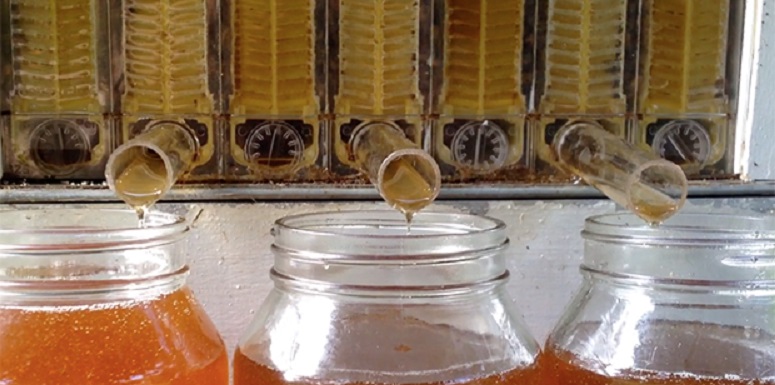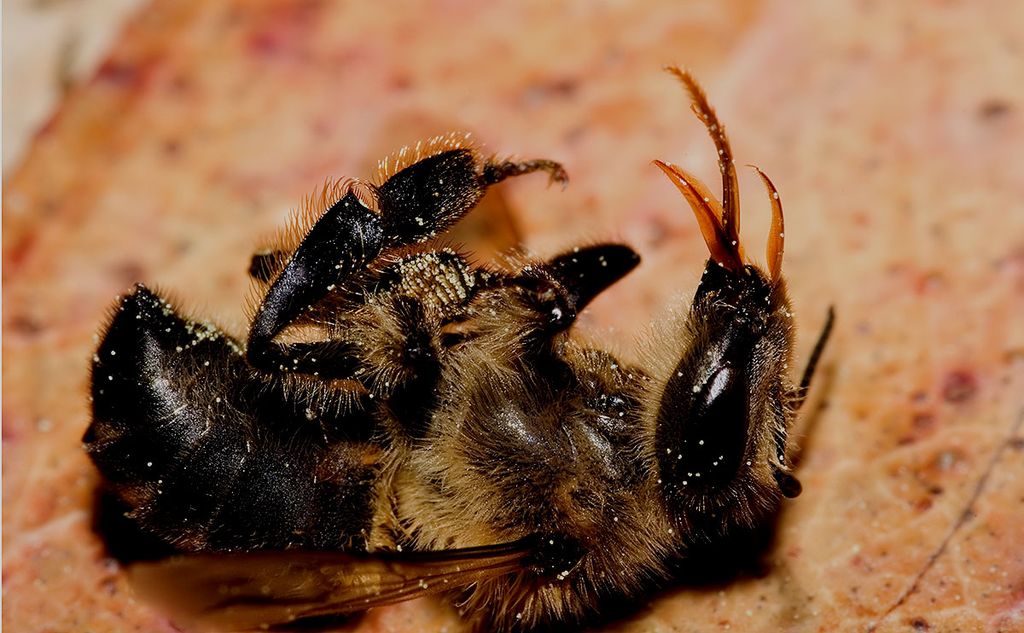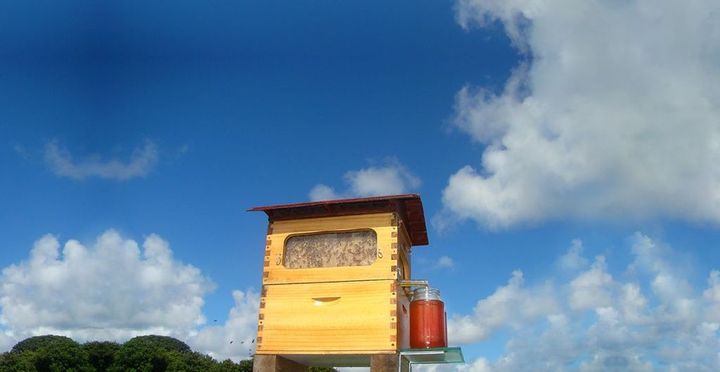
Harvesting honey is tricky and oftentimes dangerous work. Since it's earliest days, it has consisted of beekeepers opening up an artificial hive, extracting honeycomb frames manually, relying on protective gear to prevent them from getting stung and/or using smoke to render the bees docile. This process is not only messy and difficult, but is quite invasive and difficult for the bees themselves.
Luckily, after multiple generations of beekeeping and ten years of hard work, two Australian apiarists (aka. beekeepers) - Cedar Anderson and his father Stuart - have come up with a revolutionary and less-invasive way to harvest honey. Their invention is known as the Flow Hive, a device that allows beekeepers to get honey directly from their backyard beehive by simply turning on a spout and letting the honey flow into a jar.
Much like a standard honeybee hive, the Flow Hive is made up of a brood box - where the queen bee lays eggs - and one or more Flow Super frames, which are used for honey storage and extraction. The Flow frames consist of already partly formed honeycomb cells which the bees complete with their wax, filling each cells with honey and capping them off as usual.
When the spout is activated, the cells split vertically inside the comb to form channels, allowing the honey to flow down to a sealed trough at the base of the frame and out of the hive. When the honey has finished draining and the tap closed, the upper slot resets, returning the comb into its original position and allowing the bees to chew the wax capping away, and once again fill them with honey.
The Flow HIve allows for the extraction of honey from a hive without the need for processing. Credit: indiegogo.com
Traditionally, beekeepers were forced to split the boxes of the hive, smoke the bees to calm them, remove the frames, cut the wax caps from the honeycomb, and then extract and clean the honey. This is a rather long and tedious process, and is also messy, physically demanding, and does require the beekeeper to wear full-body coverings if they don't want to get stung.
Given the convenience factor of the Flow Hive, it is easy to see how the Andersons were able to quickly raise all the money they needed to make it commercially available. The duo launched a crowdfunding campaign on Indiegogo just a week ago (on Sunday, Feb. 22nd). Since that time, they have managed to raise just under $4 million USD from an original funding goal of $70.000. Clearly, demand is high!
However, beyond offering a better means of getting honey, the Flow Hive also comes with some major environmental and ecological benefits. In recent years, scientists have been announcing that the mass exctintion of various mammals may occur at an alarming rate thanks to the effect of Climate Change. But nowhere has the research been more frightening than when it comes to the global honeybee population.
While the sudden and unexplained disappearance of bees has been noted before by apiarists, the phenomena became big news in 2006 when it became evident that bees were simultaneously disappearing all across the globe. During that year, a drastic rise in the number of disappearances of western honeybee colonies in North America coincided with similar disappearances being reported all across Western, Northern and Souther Europe.

Multiple Flow Super Frames shown side by side and with multiple spouts. Credit: indiegogo.com
The syndrome, which previously went by various other names, was officially renamed Colony Collapse Disorder (CCD) in order to more accurately describe the drastic nature of it. And while the exact cause remains unknown - possible explanations range from pesticides, pathogens and parasites to the use of fungicides and antibiotics - the consequences certainly are.
According to a 2005 report from the Agriculture and Consumer Protection Department of the Food and Agriculture Organization of the United Nations, the worth of global crops that rely honeybee’s pollination was estimated to be close to $200 billion for that year. If the honeybee population is destined for extinction, it would lead to a massive downturn in the global agriculture industry, not to mention skyrocketing food prices and a sharp rise in malnutrition.
But far worse than the economic consequences are the far-ranging consequences that the disappearance of bees would have on the planet's ecosystem. If CCD continues on its current trajectory and honeybees disappear, so will all the plants that these bees pollinate. Animals that rely on these plants for their sustenance will similarly dwindle, as will the predators that eat them.

Colony Collapse Disorder describes the sudden and unexplained disappearance of worker bees from a hive. Credit: modernfarmer.com
In short, honeybee extinction will result in a cycle of death that will go all the way up the food chain, and humanity will not be spared. As we're all no doubt aware, the world's population just 7 billion at the beginning of the current decade. And according to the 2012 World Population Prospects report by the UN, that population is expected to reach 9.6 billion by mid-century. With so much concern about our capacity to feed this growing population, the last thing we need then is an agricultural crisis that will complicate matters further.
Of course, ideas like the Flow Hive are merely one proposed solution. And as it stands, honeybees are not the most efficient pollinators. However, the range of plants they are responsible for pollinating - in part or in full - make up a significant ammount of the agriculture and food we depend upon. So anything that prevents the spread of CCD is a win for both humanity and the environment.
What's more, Cedar and Stuart are confident that their device - decried by some traditionalists as promoting "lazy beekeeping" - will help increase visibility and allow beekeepers to become more knowledgeable about their bees. And the way it promotes beekeeping is also likely to be good for promoting awareness about the threat of bee extinction.
The Flow Hive comes in three sizes: a minimal three-plate set that you can add to an existing hive, a bigger plate set, and a full hive; ranging in price from $230 to $600. Shipping is set for the end of 2015, and the Indiegogo campaign (despite its early success) will be running until April 5th, 2015.
And be sure to check out the Flow Hive's promotional video:
Top image: honeyflow.com
- www.honeyflow.com/
- http://www.wired.com/2015/02/flow-hive/
- http://keepingbackyardbees.com/the-flow-hive/
- www.un.org/apps/news/story.asp?NewsID=45165#.VPOL1eFFW-c
- http://www.bbc.com/future/story/20140502-what-if-bees-went-extinct
- www.bbc.com/future/story/20140502-what-if-bees-went-extinct
- www.globalresearch.ca/death-and-extinction-of-the-bees/5375684
- http://www.globalresearch.ca/death-and-extinction-of-the-bees/5375684
- http://www.fastcoexist.com/3042783/this-amazing-beehive-from-australia-harvests-its-own-honey
- http://www.slate.com/blogs/the_eye/2015/02/27/
- www.indiegogo.com/projects/flow-hive-honey-on-tap-directly-from-your-beehive
- http://www.treehugger.com/sustainable-product-design/flow-hive-beekeeping-invention-puts-honey-tap-promotes-healthier-bee-colonies.html









